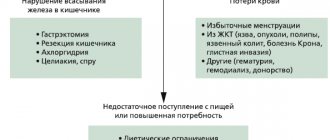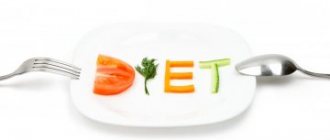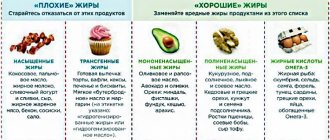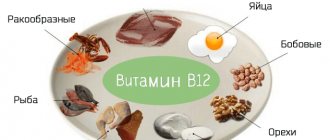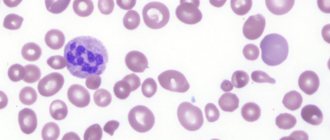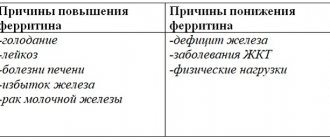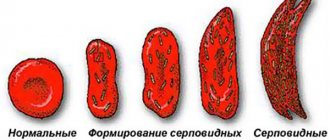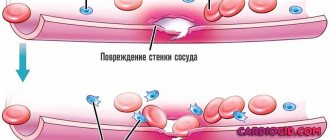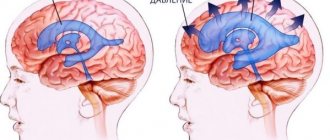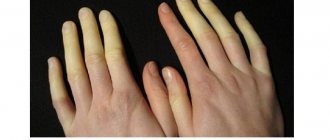Causes
Hypochromic anemia can occur for the following reasons:
- blood loss, which may be chronic or long-term, associated with uterine or gastric bleeding. This phenomenon becomes the beginning of the development of hypochromia;
- chronic inflammatory processes associated with changes in iron absorption into the gastrointestinal tract;
- malignant neoplasms in the stomach area;
- strong need for micro and macroelements, especially iron, which occurs during pregnancy, breastfeeding, as well as in younger and puberty;
- lack of iron, as well as vitamins that facilitate its absorption in food when entering the body, for example, with vegetarianism or other diets.
Treatment of microcytic anemia
The goal of therapy for microcytic anemia is to eliminate iron deficiency and its original cause. Treatment of the underlying disease is the key to successful therapy for microcytosis.
For this purpose, patients' diet is first regulated by enriching them with iron-rich foods.
Severe iron deficiency is compensated for by intramuscular or intravenous injection medications containing iron. As the condition normalizes, patients are transferred to tablet forms of drugs.
It is important not to self-medicate, since an excess of iron in the body can be more dangerous than its deficiency.
The decision to hospitalize patients depends on their condition and laboratory parameters. For example, for hemolytic anemia, outpatient or inpatient treatment is indicated in the following cases:
- mild degree - patients feel satisfactory, the spleen is slightly enlarged, outpatient treatment is indicated;
- condition of moderate severity - moderate anemia, hemolysis is often detected, the skin is yellow, the spleen is significantly enlarged. Such signs serve as an indication for hospitalization of patients;
- severe degree - severe anemia, intense jaundice, the spleen is enlarged several times, the main method of treatment for such patients is blood transfusion.
Classification of hypochromia (hypochromic anemia)
This disease can be classified into 4 types:
- iron deficiency;
- sideroachrestic;
- iron redistribution;
- mixed.
Hypochromia in a general blood test
In iron deficiency anemia, there is a lack of the required amount of hemoglobin.
This may happen for the following reasons:
- bleeding that continues for a long time, or when even a small amount of blood has been lost;
- a case when iron is poorly accepted by the body, for example, this can happen after surgery in the stomach area.
For treatment, medications with iron are prescribed. Along with drug treatment, it is recommended to maintain a special diet, which must contain meat, beets, liver and other products. With sideroachrestic anemia, which is otherwise called iron-saturated anemia, there is an excess of hemoglobin.
In this condition, the body is not able to process and produce hemoglobin.
The cause of this disease may be the following:
- chemical poisoning. This applies to those who work in enterprises with chemicals;
- long-term medication treatment.
Chemical poisoning is one of the causes of hypochomia
For treatment, it is prescribed to take the necessary vitamins, for example, vitamin B6, together with a diet that excludes meat and other products. With iron redistribution anemia, hemoglobin is not able to enter the blood system.
The reason may be the following:
- inflammatory diseases with a purulent nature;
- tuberculosis;
- invasion.
Before treating this pathology, you first need to eliminate the cause. After which a course of vitamin therapy is prescribed.
With the mixed type, there is a lack of vitamin B12, as well as iron. A person gets tired very quickly, his immune system decreases, and his upper limbs swell. This type of pathology does not require taking medications containing iron, otherwise the situation will only get worse.
Symptoms and signs
The clinical manifestations of microcytic anemia are varied. An asymptomatic course may occur, or severe hemolytic conditions may develop that require urgent medical care in a hospital setting.
The appearance of symptoms and signs of pathology can occur at any age and appear spontaneously.
Common manifestations of all microcytoses are:
- hypoxia;
- increased activity of the cardiovascular system due to oxygen deficiency. At the same time, the heart rate increases, blood pressure in the initial stages is normal or reduced. As the condition progresses, arterial hypertension develops;
- weakness, loss of consciousness;
- decreased performance, increased fatigue, drowsiness, feeling “broken”;
- decreased physical and mental activity;
- difficulty concentrating;
- dyspnea;
- blurred vision;
- headaches, dizziness;
- cheilitis (seizures);
- brittle nails and hair.
With sideropenia, patients experience taste perversions, impaired sense of smell, and frequent stomatitis.
In hemolytic anemia, one of the clearest signs of the disease is jaundice.
Microcytosis in children is accompanied by weight loss or excess weight, the need to taste inedible objects, and retardation in physical and psycho-emotional development.
In addition to clinical symptoms, all microcytic anemias are characterized by special biochemical changes due to iron deficiency:
- decrease in ferritin - a protein that is responsible for maintaining iron in the depot;
- reducing the concentration of substances in the liver and bone marrow, the task of which is the formation of heme;
- an increase in the total iron-binding capacity of blood serum due to a decrease in iron concentration;
- growth of free erythrocyte protoporphyrins. At the same time, these substances have nothing to form complexes with for heme synthesis;
- a decrease in the functionality of enzymes that are responsible for the iron content in cells.
Symptoms of pathology
The disease may be accompanied by the following symptoms:
- dizziness, which occurs quite often, there may also be manifestations of black spots or fainting;
- shortness of breath after mild physical activity;
- feeling depressed;
- rapid heartbeat;
- pale epidermis;
- change in well-being, most often an irritable state;
- fast fatiguability.
Dizziness is one of the signs of hypochomia
All of the above symptoms are characteristic of all categories of hypochromia. If suddenly they appear, then you need to do a general examination of the blood system. After the procedure, the specialist will diagnose the disease and prescribe appropriate therapy.
Prognosis and possible complications
You need to know not only what hypochromic anemia is, but also how it is dangerous. With timely treatment and elimination of all risk factors, the prognosis is favorable. With thalassemia, it gets worse and can be fatal. Complications of hypochromic anemia are:
- Cardiomyopathy (heart damage).
- Delayed psychomotor and intellectual development of the child.
- Damage to mucous membranes and skin.
- Gastritis.
- Hair loss.
- Anemic coma.
- Organ failure (lungs, kidneys, heart).
- Infectious complications.
- Arrhythmia.
- Deterioration of brain function.
The most dangerous forms of thalassemia major, in which anemia is combined with multiple organ failure.
Why is hypochromia dangerous?
Lack of hemoglobin is not a threat to human life. However, if this deficiency is not corrected with appropriate medications, complications may occur. This pathology is more often observed in the elderly generation, which leads to various diseases.
Why is hypochromia dangerous?
During pregnancy, having a lack of hemoglobin is very dangerous, since the fetus will then begin to suffer from oxygen starvation, and it may not survive in the womb. Also, a pregnant woman may experience premature labor, or the child may be born underweight and become weak-minded.
When a danger occurs, the following symptoms may appear:
- the spleen and liver will increase in size;
- an edema condition will occur;
- all limbs will become numb;
- the work of the heart will be disrupted.
Treatment
After diagnosing microcytosis and determining the initial disease, treatment is prescribed. The main goal of therapy is to eliminate the factors that lead to a decrease in red blood cells.
The range of medications is very wide, and the prescription of a particular drug directly depends on the initial disease. The therapy used is prescribed exclusively by the attending physician based on laboratory and instrumental studies.
With the correct prescription of effective drugs, the level of normocytes is restored and recovery occurs. It all depends on individual indicators, concomitant diseases and possible complications.
Since, in most cases, microcytosis is provoked by low iron, the patient is prescribed a diet with a high iron content, which helps to raise and restore hemoglobin.
Products containing high concentrations of iron include:
- Beef, pork, chicken liver, kidneys, veal, lamb,
- Mussels, oysters, shrimps,
- White mushrooms,
- Peas, red beans, soybeans, lentils,
- Spinach, potatoes, carrots, cauliflower,
- Apples, bananas, apricots, peaches, strawberries, blueberries, raspberries,
- Oatmeal,
- Wheat and rye bread,
- Chicken eggs,
- Prunes, walnuts, almonds.
Following such a diet helps both to restore iron and hemoglobin levels and to prevent their deviations.
If, after applying therapy and following a diet, hemoglobin is not restored, this indicates possible tumor formations. In this case, microcytosis will persist until the tumor is removed.
Qualitative and quantitative analysis
Hypochromia in a general blood test is the most important indicator of a blood test; thanks to it, the level of hemoglobin is assessed. However, if anemia is present, then other indicators are also taken into account, for example, qualitative and quantitative changes in the circulatory system.
Qualitative and quantitative analysis
In order to determine the morphological analysis you will need:
- investigate the smear;
- find out the size of red blood cells;
- see with your eye how much the red blood cell is saturated with hemoglobin.
When is hypochromia not associated with pathologies?
Hypochromia cannot be associated with pathologies only when a person eats the wrong way. For example, he consumes too many sweet and useless foods, which in turn leads to a decrease in the level of iron in the blood, which is confirmed by a general blood test. In this case, only adjusting the diet will help.
By maintaining proper nutrition over a long period, you can bring your hemoglobin level back to normal.
Otherwise, if you start to develop incipient anemia, organs such as:
- heart;
- spleen;
- vessels;
- kidneys;
- Gastrointestinal tract;
- liver;
- brain.
Diagnostics
The doctor may suspect anemia when examining and interviewing the patient. The specialist determines the onset of the development of symptoms of the pathology, dietary features, existing chronic diseases, and medications taken over the past months. If microcytic anemia is suspected in a pregnant woman, the doctor will check the duration of pregnancy. During the examination of the patient, the specialist pays attention to the nails, hair, color of the skin and mucous membranes of the tongue and oral cavity, evaluates muscle strength, and measures blood pressure.
After this, the patient is sent for testing. In case of anemia, the results of a general blood test determine:
- increased red blood cells;
- microcytosis - abnormally small red blood cells;
- pale pink red blood cells, which are normally bright red;
- decrease in the number of red blood cells and hemoglobin;
- increased platelet concentration;
- decrease in color index;
- increased leukocyte levels;
- decrease in the number of reticulocytes;
- decreased hematocrit level;
- increased erythrocyte sedimentation rate.
The results of a biochemical blood test determine the level of various chemical elements. This allows you to obtain information about the condition of the kidneys, liver, bone marrow, etc. Anemia is characterized by:
- decreased serum iron concentration;
- a decrease in the amount of ferritin in the blood;
- violation of the general iron-binding capacity of serum;
- an increase in erythropoietin concentration.
Important information: How to treat hereditary sideroblastic (sideroblastic) anemia and its symptoms
Diagnosis of the disease involves performing a bone marrow puncture. To do this, one of the body’s bones is pierced with a special needle and 2-3 ml of bone marrow substance is removed, which is studied under a microscope. At the very beginning of the disease, no changes are detected in the punctate. As the disease progresses, the erythroid lineage of hematopoiesis grows.
A stool examination is performed to detect occult blood. It appears as a result of many diseases. Heavy single bleeding rarely leads to anemia. Long-term blood loss, small in volume, which occurs as a result of damage to small vessels of the gastrointestinal tract, is dangerous.
To identify tumors or stomach ulcers, which often cause chronic bleeding, an X-ray with a contrast agent is used.
In addition, to determine the cause of anemia, the following is used:
- colposcopy;
- laparoscopy;
- colonoscopy;
- sigmoidoscopy;
- fibroesophagogastroduodenoscopy.
Treatment of pathology with drugs and folk remedies
Hypochromia in a general blood test, when the pathology is confirmed by a laboratory assistant, is amenable to the following drug therapy:
- "Ferrum - Lek";
- "Totem";
- "Maltofer";
- "Sorbifer";
- "Tradiferon".
Ferrum – Lek
Vitamins are also prescribed together with medications , since anemia mainly develops due to a lack of elements that are so necessary for the body:
- iron;
- copper;
- zinc;
- vitamins from group B;
- ascorbic acid;
- vitamins A, E, D.
Anemia can also be treated with folk remedies. It was in this way that ancient ancestors were treated in order to heal even a severe form of pathology.
Medicines do not always help cure anemia, as they have side effects that make it simply impossible to fully cure the disease. Therefore, thanks to traditional medicine, you can increase your hemoglobin level without any consequences. The following proven recipes can be used for traditional medicine.
Recipe No. 1. Ingredients:
- dry strawberries;
- boiling water.
Dried strawberries
Directions for use:
- Berries must be filled with 1 tbsp. hot water.
- Leave to steep under the lid closed for 4 hours.
- The tincture must be filtered before use.
- Drink the prepared decoction all at once.
Recipe No. 2. Ingredients:
- chokeberry;
- dog-rose fruit;
- boiling water.
Method of use:
- Berries must be taken in equal quantities.
- Fill them with hot water.
- The decoction should be infused in an enamel or glass container for 30 minutes.
- Filter the broth and consume several times a day.
Why does it occur
Hypochromic anemia is caused by:
- Chronic bleeding (gastrointestinal, uterine, pulmonary, menstrual). The causes may be peptic ulcer, gynecological diseases (endometritis, endometriosis, tumors, erosion), anal fissures and hemorrhoids.
- Helminthiases.
- Exudative diathesis. This is a common cause of anemia in children.
- Diseases of the blood system (blood incoagulability, hemorrhagic diathesis).
- Frequent blood donation.
- Carrying out hemodialysis.
- Chronic renal failure.
- Impaired absorption of iron. This element is part of hemoglobin. The causes of insufficient absorption of iron are parasitic infections, hypoacid gastritis, malabsorption syndrome, chronic inflammatory bowel diseases and removal of part of the stomach.
- Insufficient intake of iron from food. It is observed when there is a deficiency in the diet of meat and meat products. Vegetarians are at risk.
- Anorexia (exhaustion).
- Artificial feeding of a child.
- Liver dysfunction.
- Increased need for iron. It is observed during puberty, during infectious pathology and during pregnancy.
- Genetic mutations.
- DIC syndrome.
- Hypovitaminosis of ascorbic acid.
- Sepsis.
- Radiation sickness.
- Mechanical damage to blood vessels.
- Extensive myocardial infarction.
- Rupture of the fallopian tubes.
- Aneurysm rupture.
With hypochromic anemia, the cause may lie in systemic diseases (lupus erythematosus), vasculitis, prolonged alcohol consumption and irrational use of medications (NSAIDs, antacids, iron-binding drugs).
Important information: How to treat macrocytic anemia and its symptoms
Iron-deficiency anemia
For this pathology, it is recommended to take medications containing iron, as well as eat foods that are rich in this element. The course of therapy can be 6 months or more.
Drugs for the treatment of iron deficiency anemia include:
- "Maltofer" is given for treatment to adolescents and older adults - up to 300 mg per day (3 tablets) for 5 months, to pregnant women - up to 300 mg per day. Next, after replenishing the iron deficiency, the drug is taken for some more time, when anemia is no longer present. Teenagers and older adults are given up to 100 mg per day for 2 months;
- "Sorbifer", given to adolescents and older up to 1 tablet. 1 or 2 r. per day, if necessary, increase the dose to 4 tablets. per day. The course of therapy is 4 months. Pregnant and lactating women are given - 1 tablet. per day (for prevention), up to 1 tablet. 2 r. per day (for treatment). The drug should be taken immediately with water and should not be chewed;
- "Hemofer", given to premature babies up to 2 drops. every day up to 5 months, infants up to 1 year are given up to 19 drops. every day, children under 12 years of age are given up to 28 drops. 1 or 2 r. during the day, for adolescents - up to 28 drops. 2 r. during the day, for older people - up to 55 caps. 2 r. in a day. The drug is taken between meals, added to water or juice.
Maltofer
Traditional medicine recipes that help increase the level of hemoglobin in the blood system.
Recipe No. 1:
- dandelion (leaves, roots) 3 tbsp. l.;
- boiling water.
Mode of application:
- Medicinal raw materials must be filled with boiling water.
- Leave to infuse for 30 minutes.
- Filter.
- You need to take no more than 1 tbsp of the decoction. l. 3 r. per day.
- The course of therapy is 14 days.
Dandelion
Recipe No. 2:
- rosehip, 25 g;
- rowan, 25 g;
- boiling water.
Mode of application:
- The berries are poured with boiling water.
- Let it brew.
- Use no more than 1 tbsp. during the day.
Recipe No. 3:
- dried apricots;
- prunes;
- raisin;
- walnuts;
- lemon;
- honey, 200 g;
- fresh cranberries.
Cooking method:
- Dried fruits and nuts should be taken in equal quantities, chopped and mixed.
- Add honey and, if possible, cranberries.
- All ingredients must be in a glass container.
- Use 1 tbsp. l. 3 r. during the day on an empty stomach, before meals. Children are given - 1 tsp. no more than 3 r. per day, on an empty stomach.
How does hypochromic microcytic anemia manifest itself in children?
The parameters of the hemogram must be under control; it is mandatory for a growing organism.
Hypochromia and microcytosis during a general blood test, together with other signs of trouble (excessive weight gain or loss, an unnatural need to taste and even eat inedible foods, changes in behavior, decreased concentration) indicate that the child has anemia, which arose due to insufficient iron levels. After all, the synthesis of hemoglobin (red blood pigment) depends only on this chemical element.
It is also a carrier of oxygen through tissues and organs, and when it decreases, unpleasant symptoms characteristic of anemia occur.
Iron-rich anemia
For this pathology, it is necessary to use the following drugs:
- "Pyridoxine", for internal use no more than 200 mg per day, for intravenous infusion up to 100 mg 2 times. per week for 2 months;
- sodium salt, prescribed for lead intoxication;
- "Desferal", for intravenous infusion no more than 1000 mg with a break.
Mumiyo
The following traditional medicine methods will help reduce high hemoglobin levels:
- hirudotherapy, thanks to leeches that suck blood, red blood cells decrease. A few sessions will be enough to achieve the desired result;
- mummy, you need to take up to 1 pill, which is first dissolved in 1 tbsp. warm water overnight. The course of therapy is 10 days with a break of 5 days, repeat again;
- medicinal herbs (willowherb, chickweed and chickweed) will also help reduce high hemoglobin.
How to cure
For hypochromic anemia, treatment is complex. The goals of therapy are:
- elimination of etiological factors (treatment of helminthiases, diseases of the gastrointestinal tract, infectious pathology);
- normalization of color indicator, hemoglobin level, iron and red blood cell count;
- elimination of symptoms;
- prevention of complications.
The main aspects of treatment are:
- Following a strict diet.
- Taking medications.
- Blood transfusions (transfusion of blood components). This is required in case of low blood pressure, decreased hemoglobin and damage to vital organs.
- The use of folk remedies.
- Splenectomy. Indicated for thalassemia and increased spleen function (hypersplenism).
For thalassemia, a bone marrow transplant may be needed.
Drug therapy
When treating hypochromic anemia, the following can be used:
- Antianemic agents (Sorbifer Durules, Ferro-Folgamma, Ferrum Lek). These drugs are indicated for hypochromia in combination with iron deficiency.
- Glucocorticoids. Can be used for thalassemia.
- Anti-inflammatory drugs. Indicated for enteritis and enterocolitis.
- Antiparasitic agents (Biltricid, Vermox, Nemozol). Used for hypochromia caused by helminthiasis.
- Hemostatics (Vikasol). Indicated for hemorrhagic syndrome.
- Complexing compounds (Exjade, Desferal). Prescribed for thalassemia.
Folk remedies
Hypochromic anemia in adults and children can be treated using folk remedies. For low iron levels, beets, fermented yeast and vegetable juices are effective. For thalassemia, herbs rich in zinc and folic acid (oats, red clover, nettle, burdock root, dandelion and parsley) are used. You can prepare decoctions and infusions from them and take them orally.
Important information: How hypochromic iron deficiency anemia is treated in adults, its symptoms and proper dietary nutrition for IDA
Diet therapy
Patients need to enrich their diet with meat, offal (liver), eggs, cottage cheese, prunes, seaweed, baked beets (helps increase hemoglobin), cereals (buckwheat), apples and peaches. Vitamin C, succinic and citric acids improve the absorption of iron, so it is recommended to eat currants, cabbage, rose hips and citrus fruits.
For hypochromic anemia with iron deficiency, you need to reduce the consumption of strong tea, coffee, rice, soy, fish and seafood, milk and chocolate. Animal products are the most beneficial. This diet must be followed for at least a month until the color index normalizes.
Prevention
Methods for preventing hypochromic anemia are:
- good nutrition (including meat in the diet, enriching the menu with fruits and berries);
- refusal of vegetarianism;
- treatment of existing intestinal diseases;
- thorough hand washing before eating and heat treatment of water, meat and fish (reduces the risk of helminth infection);
- prevention of intoxication;
- treatment of vascular diseases;
- maintaining hemoglobin and red blood cell levels at the proper level;
- treatment of blood diseases;
- taking vitamins (ascorbic acid).
There is no specific prevention.
Diet therapy for hypochromia: general principles and rules
Maintaining a diet for hypochromia is not difficult, the main thing is to adhere to certain rules that will help you absorb the necessary element:
- rejection of bad habits;
- limit the consumption of coffee and tea;
- You cannot immediately consume protein dishes after fermented milk products;
- It is better to drink kefir and milk before bedtime;
- Iron-boosting drugs should not be taken with tea or coffee, only with water;
- prefer a healthy diet, avoid overly fried foods.
Recommended Products
For anemia, in order to maintain normal iron levels, it is recommended to include the following foods in the diet:
- rich in amino acids and proteins: meat products (rabbit, beef, pork, pigeon, chicken, lamb), butter and cream;
- microelements necessary for hematopoiesis are found in: beets, carrots, peas, lentils, beans, tomatoes, corn, liver, fish products, oatmeal, apricots, baker's or brewer's yeast;
- the required amount of folic acid is found in: green vegetables, salads, herbs, and breakfast cereals;
- for better absorption of iron, it is useful to drink mineral water from healing waters;
- products that are fortified with iron: bread products, baby products, confectionery products);
- Honey is well capable of absorbing iron;
- no more than 3 mg of the iron element is found in 1 tbsp. plum nectar.
Meat products
In addition to the above list, there are other products that are recommended for use in case of pathology:
- bananas;
- nuts;
- garlic;
- onion;
- apricot;
- cherry;
- viburnum;
- tomatoes;
- potato.
Prohibited Products
It is necessary to limit or completely forget about such products as:
- fat;
- milk;
- baking;
- coffee;
- Coca Cola;
- dishes with brine and vinegar;
- alcoholic drinks.
Menu for the week
Hypochromia in a general blood test indicates developing anemia, in which it is necessary to adhere to the correct diet.
Monday:
| Breakfast | Snack | Dinner | Afternoon snack | Dinner | Before bedtime |
| Milk tea, 1 slice of fillet sausage, cottage cheese + sour cream, radish and grinder salad, bread and butter. | Fruit nectar + baking. | Meat and noodle soup, fried steak + onions, fried potatoes, cauliflower, freshly cut tomatoes, strawberry cream, bread. | Fresh cream + cookies. | Omelet + green peas, bread with mala and tea. | Fruits |
Tuesday:
| Breakfast | Snack | Dinner | Afternoon snack | Dinner | Before bedtime |
| Coffee with cream, scrambled eggs, fresh cut grinder, bread and butter. | Chopped herring, bread + butter + tea. | Beetroot soup, puff pastry pies, fried veal liver, buckwheat porridge, radish and sour cream salad, pears drenched in sweet sauce, bread. | Coffee + cookies. | Vegetable salad seasoned with mayonnaise, lean ham, bread + tea. | Just kvass |
Wednesday:
| Breakfast | Snack | Dinner | Afternoon snack | Dinner | Before bedtime |
| Semolina milk porridge + little bread with Dutch cheese. | Herring, fresh cucumbers, bread, tea + cookies. | Borscht in meat broth, boiled lean meat + fried potatoes, freshly cut cauliflower, whipped cream + cherry jam, bread product. | Coffee + baked goods. | Pancakes filled with cottage cheese and fruit cream, nectar from fruits or vegetables. | Any fruit |
Thursday:
| Breakfast | Snack | Dinner | Dinner | Before bedtime |
| Boiled eggs, low-fat ham, coffee + milk, butter, bread, hematogen-based biscuit. | Buckwheat milk porridge, grated carrots or sauerkraut. | Potato soup - mashed potatoes with green peas, tenderloin or semi-fried steak, any vegetable salad, fresh fruit, bread. | Cutlets + mushrooms or vegetables, nectar from fruits or vegetables, bread product. | Rosehip berry decoction |
Friday:
| Breakfast | Snack | Dinner | Dinner | Before bedtime |
| Cottage cheese + sour cream, hematogen-based noodle maker, butter, bread, tea. | Fish pudding + egg butter sauce, fruit nectar or fresh fruit, bread product. | Liver-based brine soup, piece of beef + sauce, zucchini, berry jelly, fresh fruit, bread product. | Pike perch fried in oil in dough, fruit-based jelly, bread product. | Decoction of rose-neck berries |
Saturday:
| Breakfast | Snack | Dinner | Dinner | Before bedtime |
| Schnitzel coated in breadcrumbs, fresh vegetable salad, bread product, fruit nectar or fresh fruit. | Fried egg + fried potatoes, fresh vegetable salad, hematogen-based biscuit, fresh fruit, bread product. | Borscht with meat broth + sour cream, fried meat, boiled potatoes, cake, nectar, fresh fruit. | Pancakes based on semolina + honey and jam, milk. | Just kvass |
Sunday:
| Breakfast | Snack | Dinner | Dinner | Before bedtime |
| Pate based on herring and potatoes, or based on liver, a sandwich of butter and cheese, fresh vegetable salad, coffee, fresh fruit. | Boiled eggs, sour milk drink, bread product. | Soup based on vegetables + sour cream, pilaf based on lamb and fruits, tomatoes, nectar from fruits or vegetables, bread. | Boiled chicken meat, cheesecakes + raspberry jelly, milk. | Infusion of thorn berries |
It is important to donate blood for a general analysis once a year. Thereby protecting yourself from serious consequences if hypochromia develops.
Diet
Often, a doctor prescribes a diet for iron deficiency anemia, because With proper nutrition you can compensate for iron deficiency. The diet includes foods rich in vitamins, microelements and proteins, with a slightly reduced fat content. You should eat fractionally, 4-5 times a day in small portions. Thanks to frequent meals, appetite increases, maximum absorption of nutrients occurs, and the functioning of the digestive tract is normalized.
Important information: How to treat folate deficiency anemia and its symptoms
Food is stewed, boiled, steamed, baked, but not fried, because... During frying, fat oxidation products are formed, which are contraindicated in anemia. Liquids should be drunk 2-2.5 liters per day.
The menu should consist of the following products:
- bran bread;
- beef, kidneys;
- beef and pork liver;
- veal, beef tongue;
- greenery;
- smoked meats;
- milk and fermented milk products;
- seafood, black and red caviar;
- oatmeal, barley, buckwheat;
- poultry meat;
- canned food, fish;
- fresh vegetables;
- vegetable oil;
- honey, sugar, jam;
- eggs;
- wild strawberries, strawberries, raspberries, gooseberries, currants;
- legumes;
- decoction of oatmeal and wheat flakes, weak tea, rosehip decoction, juices with pulp.
Thanks to the diet, iron reserves are not only replenished, but also weakness, lethargy, decreased appetite, changes in taste, and dyspeptic symptoms are eliminated.
